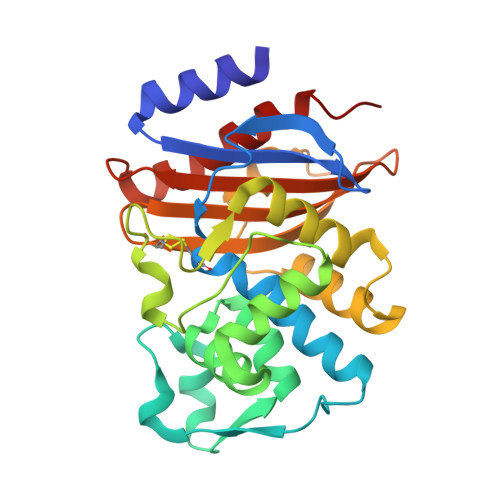Crystal Structure of the Pseudomonas aeruginosa BEL-1 Extended-Spectrum beta-Lactamase and Its Complexes with Moxalactam and Imipenem.
Pozzi, C., De Luca, F., Benvenuti, M., Poirel, L., Nordmann, P., Rossolini, G.M., Mangani, S., Docquier, J.D.(2016) Antimicrob Agents Chemother 60: 7189-7199
- PubMed: 27671060
- DOI: https://doi.org/10.1128/AAC.00936-16
- Primary Citation of Related Structures:
5EOE, 5EOO, 5EPH, 5EUA - PubMed Abstract:
BEL-1 is an acquired class A extended-spectrum β-lactamase (ESBL) found in Pseudomonas aeruginosa clinical isolates from Belgium which is divergent from other ESBLs (maximum identity of 54% with GES-type enzymes). This enzyme is efficiently inhibited by clavulanate, imipenem, and moxalactam. Crystals of BEL-1 were obtained at pH 5.6, and the structure of native BEL-1 was determined from orthorhombic and monoclinic crystal forms at 1.60-Å and 1.48-Å resolution, respectively. By soaking native BEL-1 crystals, complexes with imipenem (monoclinic form, 1.79-Å resolution) and moxalactam (orthorhombic form, 1.85-Å resolution) were also obtained. In the acyl-enzyme complexes, imipenem and moxalactam differ by the position of the α-substituent and of the carbonyl oxygen (in or out of the oxyanion hole). More surprisingly, the Ω-loop, which includes the catalytically relevant residue Glu166, was found in different conformations in the various subunits, resulting in the Glu166 side chain being rotated out of the active site or even in displacement of its Cα atom up to approximately 10 Å. A BEL-1 variant showing the single Leu162Phe substitution (BEL-2) confers a higher level of resistance to CAZ, CTX, and FEP and shows significantly lower K m values than BEL-1, especially with oxyiminocephalosporins. BEL-1 Leu162 is located at the beginning of the Ω-loop and is surrounded by Phe72, Leu139, and Leu148 (contact distances, 3.5 to 3.9 Å). This small hydrophobic cavity could not reasonably accommodate the bulkier Phe162 found in BEL-2 without altering neighboring residues or the Ω-loop itself, thus likely causing an important alteration of the enzyme kinetic properties.
Organizational Affiliation:
Dipartimento di Biotecnologie, Chimica e Farmacia, Università di Siena, Siena, Italy.





















